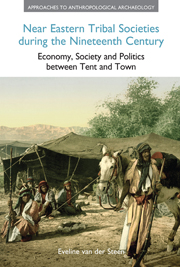 Near Eastern Tribal Societies during the Nineteenth Century
Near Eastern Tribal Societies during the Nineteenth Century For as long as we know, Near Eastern society has been fundamentally tribal. Its social structure, political institutions and economy have always been embedded in tribal frameworks. That tribal structure is not immutable, timeless or insulated from political, social and technological developments. The Near East has come a long way since the Early Bronze Age; people and societies have changed, in many cases dramatically. Nevertheless, archaeological and textual sources suggest that basic concepts of tribalism have been remarkably constant over time, and a prime mover in the history of the Near East.
Today structures of tribal organization are marginalized within small tribes on the edges of society, or transformed and incorporated within local and national governments. As a result, it is hard to imagine what a fully tribal society looked like before the age of globalization. Anthropological studies of present-day tribal societies are of little help.
There is, however, a vast pool of information, drawn from a time when the great tribes controlled the region: the observations and reports from travellers in the Near East in the nineteenth century, up to World War I (the Great War).
Napoleon's conquest of Egypt, his exploits into Palestine and the subsequent involvement of Britain shook the Ottoman Empire. The empire was already weakened by its wars with Russia and Austria, and by internal revolt. Now the French army crushed the Ottomans and they had to be rescued by the British. At the same time, the Ottoman economy was overtaken by the Industrial Revolution transforming Western Europe. Something had to give. Over the course of the nineteenth century, economic and political reform, influenced by Western ideas, although resisted by many, transformed the Near East.
To save this book to your Kindle, first ensure [email protected] is added to your Approved Personal Document E-mail List under your Personal Document Settings on the Manage Your Content and Devices page of your Amazon account. Then enter the ‘name’ part of your Kindle email address below. Find out more about saving to your Kindle.
Note you can select to save to either the @free.kindle.com or @kindle.com variations. ‘@free.kindle.com’ emails are free but can only be saved to your device when it is connected to wi-fi. ‘@kindle.com’ emails can be delivered even when you are not connected to wi-fi, but note that service fees apply.
Find out more about the Kindle Personal Document Service.
To save content items to your account, please confirm that you agree to abide by our usage policies. If this is the first time you use this feature, you will be asked to authorise Cambridge Core to connect with your account. Find out more about saving content to Dropbox.
To save content items to your account, please confirm that you agree to abide by our usage policies. If this is the first time you use this feature, you will be asked to authorise Cambridge Core to connect with your account. Find out more about saving content to Google Drive.